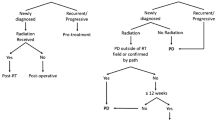Abstract
The utility of current response criteria has not been established in anaplastic astrocytoma (AA). We retrospectively reviewed MR images for 20 patients with AA and compared RANO-based approaches to clinician impression described as follow: (1) standard RANO-based criteria met by growth of or development of new enhancing lesion (RANO-C), (2) RANO criteria for progression based on significant FLAIR increase (RANO-F) and (3) clinical progression usually resulting in change of treatment (Clinical). Patterns of failure (POF) were analyzed utilizing all proposed progression MRIs fused with the patients’ radiotherapy treatment plan. With an overall median survival of 24.3 months, development of new enhancing lesion was the most common determinant of progression (70 % of patients). Median time to RANO-C, RANO-F and Clinical progression was 9.2, 9.2 and 11.76 months respectively. RANO-C and RANO-F preceded Clinical in 70 and 55 % of patients, respectively. In six patients (30 %) Clinical was concurrent with RANO-F; four of six also met RANO-C. POF for FLAIR component differed based on time point used to determine progression. FLAIR POF was more often marginal or distant when progression was defined clinically compared to either RANO-C or RANO-F criteria. Central POF based on FLAIR at Clinical determination of progression was associated with significantly poorer OS (9.8 vs. 34.4 months). Clinical progression occurs later than progression determined by RANO-based criteria. Evaluation of POF based on FLAIR signal abnormality at the time of clinical progression suggests central recurrences are associated with worse survival.


Similar content being viewed by others
References
Chamberlain MC, Chowdhary SA, Glantz MJ (2008) Anaplastic astrocytomas: biology and treatment. Expert Rev Neurother 8:575–586
Ostrom QT, Gittleman H, Farah P, Ondracek A, Chen Y, Wolinsky Y, Stroup NE, Kruchko C, Barnholtz-Sloan JS (2013) CBTRUS statistical report: primary brain and central nervous system tumors diagnosed in the United States in 2006–2010. Neuro-oncology 15(Suppl 2):ii1–ii156
Appin CL, Brat DJ (2014) Molecular genetics of gliomas. Cancer J (Sudbury, Mass) 20:66–72
WHO (1979) Handbook for reporting results of cancer treatment. Offset Publication No. 48. World Health Organization, Geneva
Macdonald DR, Cascino TL, Schold SC, Cairncross JG (1990) Response criteria for phase II studies of supratentorial malignant glioma. J Clin Oncol 8:1277–1280
Therasse P, Arbuck SG, Eisenhauer EA et al (2000) New guidelines to evaluate the response to treatment in solid tumors. European Organization for Research and Treatment of Cancer, National Cancer Institute of the United States, National Cancer Institute of Canada. J Natl Cancer Inst 92:205–216
Wen PY, Macdonald DR, Reardon DA et al (2010) Updated response assessment criteria for high-grade gliomas: response assessment in neuro-oncology working group. J Clin Oncol 28:1963–1972
Vos MJ, Uitdehaag BMJ, Barkhof F, Heimans JJ, Baayen HC, Boogerd W, Castelijns JA, Elkhuizen PHM, Postma TJ (2003) Interobserver variability in the radiological assessment of response to chemotherapy in glioma. Neurology 60:826–830
Van den Bent MJ, Wefel JS, Schiff D et al (2011) Response assessment in neuro-oncology (a report of the RANO group): assessment of outcome in trials of diffuse low-grade gliomas. Lancet Oncol 12:583–593
Chan JL, Lee SW, Fraass BA, Normolle DP, Greenberg HS, Junck LR, Gebarski SS, Sandler HM (2002) Survival and failure patterns of high-grade gliomas after three-dimensional conformal radiotherapy. J Clin Oncol 20:1635–1642
Ryken TC, Aygun N, Morris J, Schweizer M, Nair R, Spracklen C, Kalkanis SN, Olson JJ (2014) The role of imaging in the management of progressive glioblastoma : a systematic review and evidence-based clinical practice guideline. J Neurooncol 118:435–460
Polley M-YC, Lamborn KR, Chang SM, Butowski N, Clarke JL, Prados M (2010) Six-month progression-free survival as an alternative primary efficacy endpoint to overall survival in newly diagnosed glioblastoma patients receiving temozolomide. Neuro-oncology 12:274–282
Petrecca K, Guiot M-C, Panet-Raymond V, Souhami L (2013) Failure pattern following complete resection plus radiotherapy and temozolomide is at the resection margin in patients with glioblastoma. J Neurooncol 111:19–23
Chen C, Huang R, MacLean A, Muzikansky A, Mukundan S, Wen PY, Norden AD (2013) Recurrent high-grade glioma treated with bevacizumab: prognostic value of MGMT methylation, EGFR status and pretreatment MRI in determining response and survival. J Neurooncol 115:267–276
Kamoun WS, Ley CD, Farrar CT et al (2009) Edema control by cediranib, a vascular endothelial growth factor receptor-targeted kinase inhibitor, prolongs survival despite persistent brain tumor growth in mice. J Clin Oncol 27:2542–2552
Nuño M, Birch K, Mukherjee D, Sarmiento JM, Black KL (2013) Survival and prognostic factors of anaplastic gliomas. Neurosurgery 73:458–465 quiz 465
Kizilbash SH, Giannini C, Voss JS, Decker PA, Jenkins RB, Hardie J, Laack NN, Parney IF, Uhm JH, Buckner JC (2014) The impact of concurrent temozolomide with adjuvant radiation and IDH mutation status among patients with anaplastic astrocytoma. J Neuro-oncol 120:85–93. doi:10.1007/s11060-014-1520-4
Baldock AL, Yagle K, Born DE et al (2014) Invasion and proliferation kinetics in enhancing gliomas predict IDH1 mutation status. J Neuro-oncolo 16:779–786
Acknowledgments
This study was supported by the Mayo Clinic Brain Cancer Specialized Program of Research Excellence (SPORE) (National Institutes of Health -5P50CA108961-08). Supported by European Regional Development Fund - Project FNUSA-ICRC (No. CZ.1.05/1.1.00/02.0123) and by Support of Study Stays of Czech Researchers Abroad II: Young Talent Incubator (CZ.1.07/2.3.00/20.0117). Supported by MH CZ - DRO (MMCI, 00209805).
Conflict of interest
The authors declare that they have no conflict of interest.
Author information
Authors and Affiliations
Corresponding author
Rights and permissions
About this article
Cite this article
Kazda, T., Hardie, J.G., Pafundi, D.H. et al. Evaluation of RANO response criteria compared to clinician evaluation in WHO grade III anaplastic astrocytoma: implications for clinical trial reporting and patterns of failure. J Neurooncol 122, 197–203 (2015). https://doi.org/10.1007/s11060-014-1703-z
Received:
Accepted:
Published:
Issue Date:
DOI: https://doi.org/10.1007/s11060-014-1703-z




